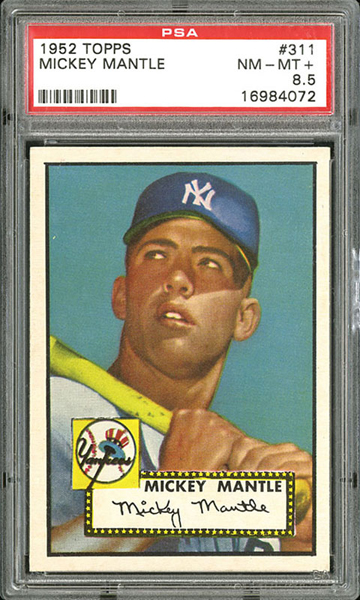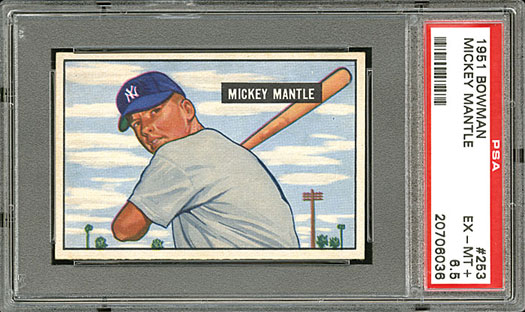
Unfortunately, due to a gross global misunderstanding, the debate over which is Mickey Mantle’s true rookie card is a never-ending one. For as long as I’ve been in this hobby, I’ve repeatedly heard collectors from all corners of the knowledge spectrum claim that the 1952 Topps card is the true rookie card. While that card is important and certainly more iconic than the 1951 Bowman card, it’s not a rookie card.
Mickey Mantle has only one rookie card and it’s from 1951 Bowman. Let me say that one more time – the 1951 Bowman card is Mickey Mantle’s ONLY rookie card. Joe Orlando:1 Former President, PSA; Former CEO, Collectors Universe Inc. agrees.2 Disagree with Joe and I? Before you commit to the common misunderstanding, consider the following solid factual reasons why the 1952 Topps card, while certainly more iconic and valuable, isn’t in any way, a rookie card.
While reading, keep in mind the following is the same yesterday, today, and tomorrow. Rookie card designation hasn’t changed. Period.
1. Performance Minimums Required to Achieve Rookie Status
In order to achieve Rookie Status, MLB requires a batter to exceed 130 at-bats.3 In 1951, Mickey Mantle had 341 at-bats making him more than qualify for rookie status during the ’51 campaign.4 What this means is the 1952 Topps card isn’t even a Rookie Year card.
2. Time of Release
1951 Bowman and 1952 Topps are both fully licensed flagship products and Mickey Mantle is featured in both sets. However, 1951 Bowman was released one year before 1952 Topps making the Bowman card his inaugural appearance on licensed cardboard. Since the Topps card came out one year after the Bowman card, it can’t be a rookie card.
It gets more technical and the following information bulletproofs our case. Read on.
Mickey Mantle’s MLB debut was on April 17, 1951.5 1951 Bowman is composed of 7 series’, each released in succession between April and July of 1951.6 The Mickey Mantle card introduces the 7th Series (#253-324), which was released in July of 1951.7
Between April 17 and June 30 of 1951 Mickey Mantle logged 233 at-bats, which means he exceeded the 130-at-bat rookie status requirement set by MLB before the 7th series of 1951 Bowman was released.8 Given this important fact, the 1951 Bowman card stands as the only true rookie card.
3. The FTC Blunder
Some claim that because 1952 was the year Topps produced a flagship set9 and it’s Mantle’s First Topps Card (FTC) that somehow this translates to it being a rookie card. If that logic is true than the following cards would also have to be considered rookie cards:
- 1952 Topps Willie Mays (FTC). Mays is found in 1951 Bowman.
- Any card from 1952 Topps featuring a player not in either of the 1951 Topps sets would all be FTC status.
- 1953 Topps Whitey Ford (FTC). Ford is found in 1951 Bowman.
- 1981 Fleer or Donruss anything Rickey Henderson (FFC & FDC). Henderson is found in 1980 Topps.
- 1985 Topps Joe Carter (FTC). Carter is found in 1984 Donruss.
- 1991 Upper Deck Frank Thomas (FUDC). Thomas is found in various licensed products from 1990.
- As long as we’re on this topic, we may as well go all in. If this logic is true and since 1993 was the first year of Topps Finest, then every single card in the 1993 Finest set would also have to be considered a rookie card. Are you actually going to sit there and believe the 1993 Finest Nolan Ryan is a rookie card? Really?10
There are countless examples to showcase this F[brand]C logic and each is the same as saying the 1952 Topps Mickey Mantle is a rookie card.
First appearances in brand releases don’t translate, or relate in any way, to rookie card status. Even if the release is from the brands inaugural year, it doesn’t matter. It’s the next logical step for players to be featured in other sets after their rookie cards are produced. By definition, succeeding issues can’t be rookie cards.
4. ‘RC’ Designation alongside Card Listing
Price guides are known to print the ‘RC’ acronym next to the card listing for the players rookie card. There’s not a single mainstream price guide anywhere with ‘RC’ printed next to the listing for 1952 Topps card #311. You’ll only find that acronym, or something like it, printed next to the listing for 1951 Bowman card #253.

For these reasons, the 1952 Topps Mickey Mantle isn’t a rookie card.
The 1952 Topps card is important for other reasons and it holds paramount historical significance. The 1952 Topps Mickey Mantle card is one the most iconic post-war cards and likely the most recognized baseball card ever made. It hails from the most important Topps set ever produced and is the first card in the extremely scarce high numbers run (#311-407) that concludes the set. For these reasons, the 1952 Topps Mickey Mantle is more iconic, desirable, and valuable than his true rookie card from 1951 Bowman.
But, it’s still not a rookie card. Any claim otherwise is just conjecture.
To see the current eBay auctions for the 1952 Topps Mickey Mantle, click here.
References:
- Joe Orlando Named CEO of Collectors Universe, Inc. www.psacard.com ↩︎
- Baseball Card Face-Off: Mantle versus Mantle. www.psacard.com ↩︎
- MLB Miscellany: Rules, regulations and statistics. mlb.mlb.com ↩︎
- Mickey Mantle. www.baseball-reference.com ↩︎
- MLB Prospects: This Date in MLB Prospect Debuts (April 17): Mickey Mantle, 1951. bleacherreport.com ↩︎
- www.1951bowmanbaseballcards.com ↩︎
- 1951 Bowman Baseball – Estimating Series Print Dates. pjdenterprises.com ↩︎
- Mickey Mantle 1951 Batting Game Log. www.baseball-reference.com ↩︎
- It wasn’t the first Topps set, however. Topps produced Red Back and Blue Back sets in 1951, and a college football set in 1950. ↩︎
- 1993 was the final year of Nolan Ryan’s prolific 27-year career. ↩︎

 Have you visited our store? Click here.
Have you visited our store? Click here.



Is this really still being debated? I can understand initial confusion because of the fact that the 52 Topps Mantle is more widely recognized, desirable, and less available than the 51 Bowman. Hopefully after a short education in baseball card history one would realize that the 52 Mantle is not his true rookie card. Personally I would rather have his 51 Bowman. It is a stunning card in and of itself and were it as scarce as the 52 Mantle I believe it would be the most talked about card in the last 50 years.
Sadly, yes it’s still being debated. I don’t think it’ll ever dissolve entirely. I believe there will always be some number of collectors who think the ’52T is the RC. I hope in those instances, this article will serve as helpful education. Thanks for the comment.